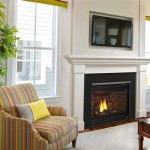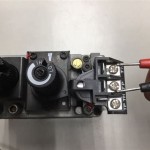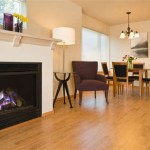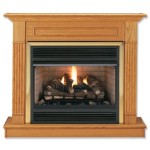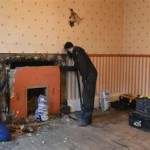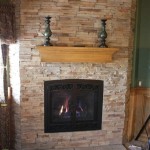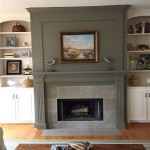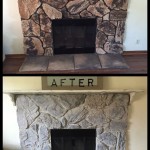36 Inch Gas Fireplace Logs: A Detailed Overview
Gas fireplace logs offer a convenient and aesthetically pleasing alternative to traditional wood-burning fireplaces. They provide the ambiance of a natural fire without the hassle of sourcing, storing, and cleaning up wood. A 36-inch set of gas fireplace logs, in particular, is designed for medium to large fireplaces, offering a substantial visual presence and a significant heat output. This article explores the various aspects of 36-inch gas fireplace logs, including their types, materials, advantages, installation considerations, and safety protocols.
The primary function of gas fireplace logs is to create a realistic and visually appealing imitation of a wood-burning fire. These logs are typically crafted from ceramic or refractory cement and are arranged within a fireplace to mimic the appearance of stacked firewood. When natural gas or propane flows through a burner beneath the logs, flames emerge, creating the illusion of a genuine wood fire. The heat generated by the flames radiates into the room, providing warmth and comfort. Unlike wood-burning fireplaces, gas fireplaces offer instant ignition, adjustable flame height, and no need for manual refueling. This makes them a convenient and user-friendly heating option.
The perceived realism of a gas fireplace log set is determined by several factors, including the detail of the log molding, the coloration, and the flame pattern produced by the burner. Manufacturers employ various techniques to enhance the realism, such as incorporating realistic bark textures, charred areas, and subtle variations in color. The arrangement of the logs within the fireplace also plays a crucial role in creating a believable fire effect. A well-designed log set will feature logs of varying sizes and shapes, arranged in a natural-looking configuration.
Types of 36 Inch Gas Fireplace Logs
36-inch gas fireplace logs can be broadly categorized into two main types: vented and ventless. Each type has distinct characteristics and installation requirements.
Vented Gas Logs: Vented gas logs are designed for use in fireplaces with a fully functional chimney that is open and unobstructed. These logs produce a realistic flame pattern and a considerable amount of heat, but they also require a significant amount of ventilation to exhaust the combustion byproducts safely. The damper must be fully open whenever the fireplace is in use to prevent carbon monoxide buildup. Vented gas logs are primarily intended for aesthetic purposes, providing the look and feel of a real fire, although they do contribute to room heating. Because a large amount of heat is lost up the chimney, they are less efficient at heating than ventless models.
The installation of vented gas logs typically involves placing the logs on a grate above a gas burner. The burner distributes the gas evenly beneath the logs, creating a uniform flame pattern. Because they rely on an open chimney for ventilation, vented gas logs are generally simpler to install than ventless models. However, it is crucial to ensure that the chimney is properly inspected and cleaned before installing vented gas logs to prevent any potential hazards.
Ventless Gas Logs: Ventless, or vent-free, gas logs are designed for use in fireplaces without a chimney or with a closed damper. These logs are engineered to burn gas more efficiently and completely, producing minimal combustion byproducts. They require a special oxygen depletion sensor (ODS) that shuts off the gas supply if the oxygen level in the room drops to an unsafe level. Ventless gas logs are more efficient at heating a room than vented logs because they do not rely on a chimney to exhaust the combustion byproducts. All the heat generated by the flame is radiated into the room.
The installation of ventless gas logs requires careful attention to detail and adherence to manufacturer's instructions. It is essential to ensure that the fireplace is properly sized for the heat output of the logs and that the room has adequate ventilation to prevent the buildup of moisture and other combustion byproducts. While ventless logs produce minimal carbon monoxide, it is still recommended to install a carbon monoxide detector in the room as an extra safety measure.
Choosing between vented and ventless gas logs depends on several factors, including the presence of a chimney, the desired level of heat output, and the aesthetic preferences. Vented logs offer a more realistic flame appearance, while ventless logs provide greater heating efficiency. Proper installation and maintenance are crucial for both types to ensure safe and reliable operation.
Materials Used in 36 Inch Gas Fireplace Logs
The materials used in the construction of gas fireplace logs play a significant role in their durability, appearance, and heat retention. The two most common materials are ceramic and refractory cement.
Ceramic Logs: Ceramic logs are typically made from a lightweight ceramic fiber material that is molded to resemble natural wood. Ceramic logs are known for their realistic appearance and intricate detailing. They are also relatively lightweight, making them easier to handle during installation and maintenance. Ceramic logs are less durable than refractory cement logs and are more prone to chipping or cracking if mishandled. However, they are generally less expensive and offer a wider range of aesthetic options.
The manufacturing process for ceramic logs involves creating a mold based on a real wood log. The ceramic fiber material is then poured into the mold and baked at high temperatures to harden. Once the log has cooled, it is carefully painted and detailed to enhance its realism. The paint used on ceramic logs is typically heat-resistant to prevent fading or discoloration over time.
Refractory Cement Logs: Refractory cement logs are made from a dense, heat-resistant material that is designed to withstand high temperatures. These logs are more durable than ceramic logs and are less likely to crack or chip. Refractory cement logs also retain heat more effectively, providing a more consistent and longer-lasting warmth. Refractory cement logs are heavier than ceramic logs, which can make them more challenging to install and handle. They are also generally more expensive, but their increased durability and heat retention make them a worthwhile investment for many homeowners.
The manufacturing process for refractory cement logs involves mixing cement with various additives to enhance its heat resistance and durability. The mixture is then poured into a mold and allowed to cure. Once the log has cured, it is carefully textured and colored to resemble natural wood. Refractory cement logs are often reinforced with steel fibers to further enhance their strength and prevent cracking.
The choice between ceramic and refractory cement logs depends on individual preferences and priorities. Ceramic logs offer a more realistic appearance and are generally less expensive, while refractory cement logs provide greater durability and heat retention. Regardless of the material chosen, it is essential to select logs that are specifically designed for use in gas fireplaces and that meet all applicable safety standards.
Installation and Safety Considerations
Proper installation and adherence to safety protocols are essential for the safe and reliable operation of 36-inch gas fireplace logs. Incorrect installation can lead to gas leaks, carbon monoxide buildup, and other potentially hazardous situations. It is always recommended to hire a qualified professional to install gas fireplace logs, especially if you are not experienced in working with gas lines.
Installation Requirements: The installation of gas fireplace logs typically involves connecting the logs to a gas supply line, placing the logs on a grate or burner, and ensuring that the fireplace has adequate ventilation. The specific installation requirements vary depending on the type of logs (vented or ventless) and the model of the fireplace. It is crucial to carefully read and follow the manufacturer's instructions during the installation process.
Before beginning the installation, it is essential to turn off the gas supply to the fireplace and ensure that the area is well-ventilated. The gas line should be inspected for any leaks or damage, and any necessary repairs should be made before proceeding. The logs should be placed on the grate or burner in accordance with the manufacturer's instructions, ensuring that they are properly positioned and aligned.
For vented gas logs, it is crucial to ensure that the chimney is open and unobstructed. The damper should be fully open whenever the fireplace is in use to allow for proper ventilation. For ventless gas logs, it is essential to ensure that the room has adequate ventilation to prevent the buildup of moisture and other combustion byproducts. A carbon monoxide detector should be installed in the room as an extra safety measure.
Safety Protocols: Several safety protocols should be followed when using gas fireplace logs to prevent accidents and ensure safe operation. It is essential to never leave a gas fireplace unattended while it is in use. Children and pets should be kept away from the fireplace to prevent burns or other injuries. Flammable materials, such as curtains, furniture, and paper, should be kept a safe distance from the fireplace to prevent fires.
Regular maintenance is also crucial for ensuring the safe and reliable operation of gas fireplace logs. The logs should be inspected regularly for any signs of damage or deterioration. The burner should be cleaned periodically to remove any debris or buildup that could interfere with the flame pattern. The gas line should be inspected annually by a qualified professional to check for leaks or other potential problems.
If you smell gas or suspect a gas leak, immediately turn off the gas supply to the fireplace and evacuate the area. Contact your local gas company or a qualified professional to inspect the gas line and make any necessary repairs. Never attempt to repair a gas leak yourself.
By following these installation requirements and safety protocols, you can enjoy the warmth and ambiance of your 36-inch gas fireplace logs safely and responsibly.
In addition to choosing the right type of logs and ensuring proper installation, homeowners should also consider the aesthetic aspects of their gas fireplace log set. The coloration, texture, and arrangement of the logs can significantly impact the overall appearance of the fireplace. Many manufacturers offer a variety of log styles to suit different tastes and décor styles. Some homeowners prefer a more rustic look with charred and weathered logs, while others prefer a more refined look with smooth and evenly colored logs.

Napoleon Blko36 Birch Log Set For 36 Inch Riverside Outdoor Gas Fireplace

Superior Complete 36 Giant Timbers Concrete Vent Free Gas Log Set With Mega Flame Burner Lmf36 Gt
-Vented_q8bs-66_pt4w-91_taba-3o.jpg?strip=all)
Bonfire 36 Inch Gas Log Set For Masonry Fireplaces
-Vented_q8bs-66_pt4w-91_taba-3o.jpg?strip=all)
Bonfire 36 Inch Gas Log Set For Masonry Fireplaces

Majestic Logs Drtwood 36 Inch Driftwood Log Set

Arizona Weathered Oak 36 Inch Vented See Through Gas Fireplace Logs Set

Superior Vrt3536 36 Inch Firebox With Vent Free Gas Log Set

Peterson Real Fyre 36 Inch Golden Oak Outdoor Gas Log Set With Vented Natural Stainless G45 Burner Match Light R Ss Bbqgrills Com

Peterson Real Fyre 36 Inch Golden Oak See Thru Gas Logs Only Burner Not Included R 2 Bbqgrills Com

Elevation 36 E36nte Napoleon

